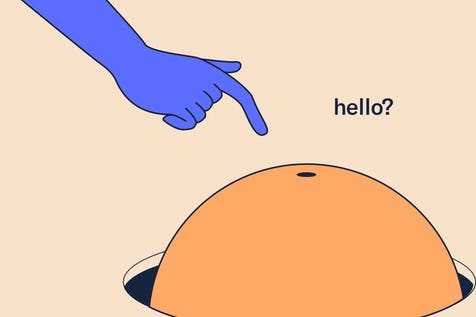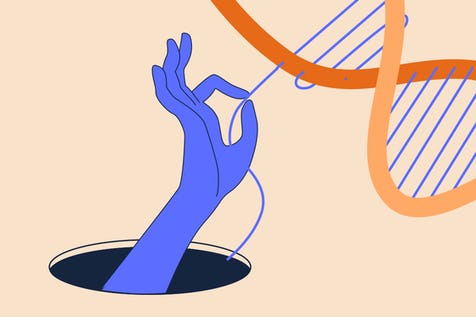The act of creating and releasing milk from the breasts is called lactation - a complex process that is most commonly associated with people feeding babies from their breasts.
However, did you know that lactation actually begins before a baby is born? In fact, in some cases, people are able to lactate without giving birth to a baby.
Whether you were breastfed as a baby, are hoping to breastfeed a baby in the future or simply want to better understand your body, this article will help you understand what is involved in lactation.
We will break down the reasons for lactation and the different factors that can start, support or stop this process.
Why do people lactate?
Biologically, we have evolved to lactate as a way to provide an ideal source of nutrition to our infants, and to support their immune systems [1]. Breastfeeding also helps with the bonding between a parent and their baby, as well as providing a variety of other health benefits [2].
What is human milk made of?
The content of milk is mostly water but the other elements can vary depending on how long you have been lactating, how often you release milk and, amazingly, the time of day.
You might have heard of colostrum, which is also known as the ‘first milk’ because it is the initial milk produced after you give birth. However, you might be more familiar with the ‘mature milk’ that follows after.
So what’s the deal with lactation vs. colostrum?
Basically, colostrum is created halfway through a pregnancy and is released within the first few days after giving birth. It is a thick, yellow fluid that is packed with nutrients and antibodies to support a newborn’s immune system. It’s high in protein but low in fats and carbohydrates, and is only made in small amounts [3].
Around 10-14 days after birth, the breasts then slowly change to releasing mature milk, which is made in large quantities and is higher in carbohydrates and fat. It also contains nutrients like calcium, magnesium and Vitamin C [3].
Interestingly, breast milk can change during one breastfeeding or pumping session - the foremilk at the beginning tends to be more watery, while the hindmilk towards the end is higher in fat. The more often milk is released, the higher in fat it will be [2].
Milk is also fattier in the morning than it is overnight [2].
Where does milk come from?
Milk is created and stored in a part of the breasts called the alveoli, which are small sacs that are grouped together in bundles. The milk is carried from the alveoli through small tubes called ducts that widen directly under the areola (the darker, bumpy skin at the centre of each breast). The ducts are connected to tiny holes on the surface of the nipples - the raised section of the areola where milk is released [4].
Breasts begin preparing for lactation before you are born. Breast development begins when an unborn baby is around five weeks old. Breasts do not develop much more until puberty (around two years prior to your first period) when they go through significant maturity and growth [4].
They continue to develop and adapt during pregnancy in readiness for colostrum production [5].
How is milk produced?
In most cases, breast milk is created as a result of hormones that circulate during pregnancy and following birth. During this time, these hormones send messages to the brain and breasts to begin making milk.
Lactation occurs in three stages:
- This first stage takes place in the second trimester of pregnancy, around the 15-20 week mark. Colostrum is produced due to breast growth and increasing levels of a hormone called prolactin. However, colostrum is not generally released from the breasts during this stage due to high levels of the hormones estrogen and progesterone, which stop this from occurring [6].
- The second stage of milk production is often referred to as “milk coming in'' as it marks the beginning of milk being produced and released in larger amounts. This begins around 30-40 hours after birth and is triggered by the birth of both the infant and the placenta. This stage is supported by high levels of prolactin, in combination with decreasing levels of progesterone and estrogen. You will typically feel breast fullness in this stage as the breasts fill with milk [6].
- The third stage of lactation occurs when milk begins being removed from the breasts. When milk is released through a baby suckling, hand expressing of milk or by using a breast milk pump, this signals to a part of the brain called the hypothalamus. The brain then signals for the breasts to produce more milk [6]. This means, the more milk you release, the more you create!
Once lactation is established, the breasts will release milk in response to the milk ejection reflex, which you might know as the let down reflex. This automatic function is triggered when the nipples are stimulated by an infant suckling. However, it can also be triggered by the sound of a baby crying, when thinking about a baby or when preparing to breastfeed [6].
What causes issues with lactation?
There are many factors that can cause someone to not lactate or have a low milk supply, from underlying health issues to complications during pregnancy. Lactation can also stop temporarily due to physical or emotional factors.
Some people may be unable to produce breast milk at all following a pregnancy due to underlying causes such as having underdeveloped breasts [2]. However, it’s worth mentioning that having smaller breasts does not typically cause issues with lactation or determine how much milk you can make in a day [6].
Other risk factors for being unable to produce breast milk include:
- Breast surgery
- Hormonal issues
- Illnesses such as diabetes
- Viruses and infections, and
- Drug use [2].
Another thing to consider is that breastfeeding soon after birth is important for establishing a breast milk supply. This means that situations, where parents are separated from their babies straight after birth, may impact a person’s ability to produce milk [2].
Breast milk supply may also stop suddenly in cases where a person experiences physical pain, embarrassment, fear or stress as this can trigger the hormone adrenaline, which can interfere with the lactation hormone oxytocin. Disruptions to regular breastfeeding sessions, such as returning to the workforce, can also impact supply [2].
What can you do to promote lactation?
If you are already lactating and wish to maintain or increase your breast milk supply, the best way is to release milk frequently and ensure your breasts are completely drained each time, as this encourages milk production [2].
You can also explore galactagogues, which are medicines, foods and herbs that support the body to produce breast milk. Your health care professional may prescribe medications such as domperidone or herbs like fenugreek and milk thistle to improve your supply [4].
Certain foods such as oats and flaxseed are also thought to improve lactation and often feature in lactation cookies, but there is limited evidence to confirm their effectiveness.
Of course, you should not begin taking any medicines or herbs without first speaking with your healthcare practitioner.
Is it possible to lactate if you have not given birth?
Yes! Spontaneous lactation or galactorrhea can occur in all people who have raised levels of the hormones estrogen and progesterone as a result of medical conditions or medication [7].
It is also possible to bring on or re-establish lactation in people with uteruses using medication, hormone therapy and nipple stimulation [2].
How can you stop lactation?
The best way to stop your breasts from producing milk is to slowly reduce the amount of milk being released over a period of time [8].
It is recommended to approach weaning gradually, as stopping suddenly can cause a buildup of milk in your breasts. This can be quite painful and can lead to mastitis, a condition that causes your breasts to become red and swollen and sometimes requires antibiotics. Another option is to use specific medications prescribed by a medical professional to stop the production of milk [2].
Conclusion
It is clear that lactation is a complicated process that is unique to each person who experiences it.
For many people, it is an incredible rite of passage, and for others, it is an unwanted side effect.
While lactation is an automatic body function, it is helpful to know there are ways you can support or stop it, depending on your circumstances. Of course, when it comes to your body, if you feel there is something not quite right, you should reach out to your healthcare professional.
References
- Andreas, N. J., Kampmann, B., & Le-Doare, K. M. (2015). Human breast milk: A review on its composition and bioactivity. Early Human Development, 91(11), 629-635. doi: 10.1016/j.earlhumdev.2015.08.013
- Amir, L. H., & Livingstone, V. H. (2016). Management of common lactation and breastfeeding problems. Management of Breast Diseases (pp. 81-104). Springer, Cham. doi: 10.1007/978-3-319-46356-8_5
- Dahl, L. (2015). Anatomy and Physiology of Breastfeeding. Clinician’s Guide to Breastfeeding, 17-34. doi: 10.1007/978-3-319-18194-3_2
- Sadovnikova, A., Wysolmerski, J. J., & Hovey, R. C. (2020). The onset and maintenance of human lactation and its endocrine regulation. Maternal-Fetal and Neonatal Endocrinology (pp. 189-205). Academic Press. doi: 10.1016/B978-0-12-814823-5.00014-3
- Alex, A., Bhandary, E., & McGuire, K. P. (2020). Anatomy and physiology of the breast during pregnancy and lactation. Diseases of the Breast During Pregnancy and Lactation, 3-7. 10.1007/978-3-030-41596-9_1
- Sriraman, N. K. (2017). The nuts and bolts of breastfeeding: Anatomy and physiology of lactation. Current Problems in Pediatric and Adolescent Health Care, 47(12), 305-310. doi: 10.1016/j.cppeds.2017.10.001
- Al-Chalabi, M., Bass, A. N., & Alsalman, I. (2018). Physiology, prolactin. StatPearls. https://europepmc.org/article/NBK/nbk507829
- Grueger, B., Canadian Paediatric Society, & Community Paediatrics Committee. (2013). Weaning from the breast. Paediatrics & Child Health, 18(4), 210-210. doi: 10.1093/pch/18.4.210








